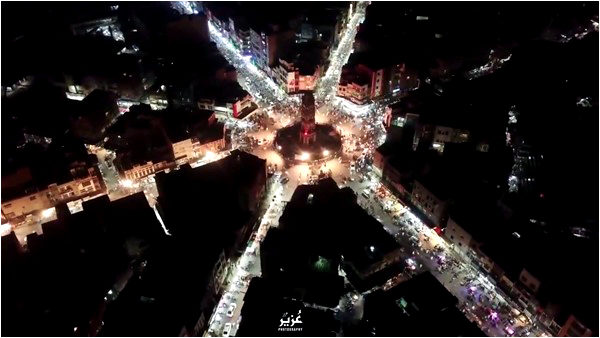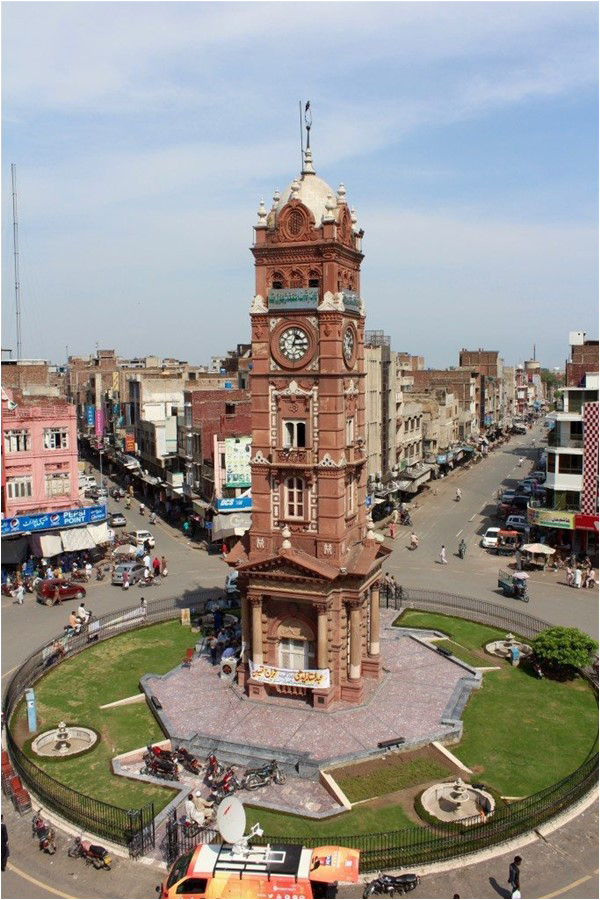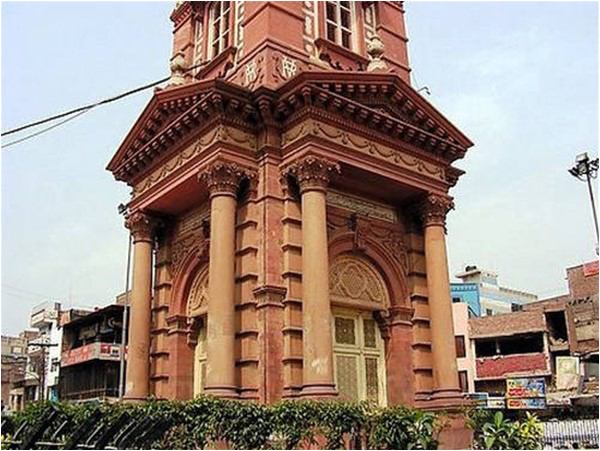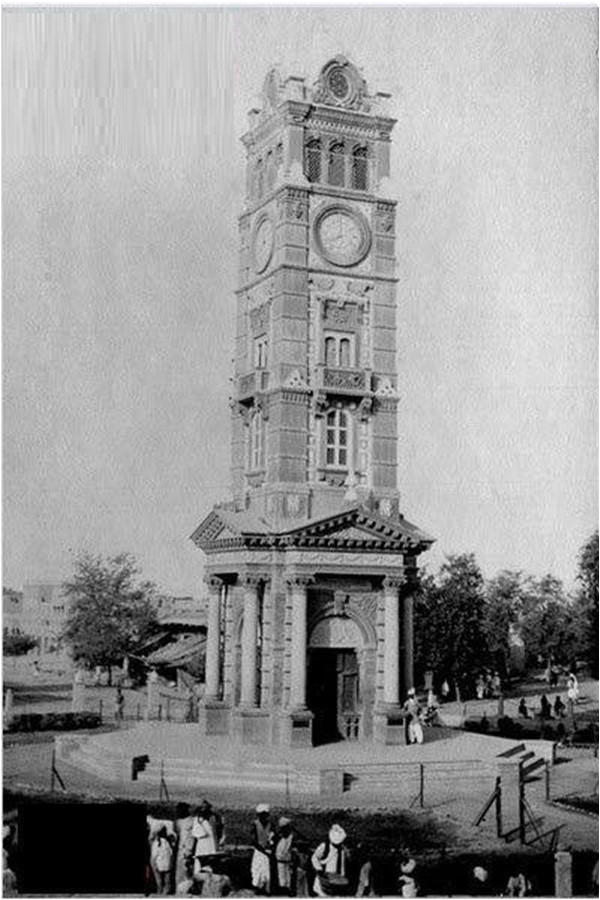Broken Beginning
By Fathima Sheikh
The Friday Times : 29 Jun 2018
No one really knows when Faisalabad’s Ghanta Ghar fell silent. Fathima Sheikh walks us through the commercial hub that grew around it

Aerial view by night
The Ghanta Ghar (Hour House), the Union Jack, the Clock Tower – these are all names associated with the historical monument that still stands at the centre of Faisalabad.
Faisalabad, formerly known as Lyallpur, is the second largest and third most populous city in Punjab, Pakistan. As home to some of Pakistan’s biggest cotton, maize and sugar mills, the city has gained a reputation as a melting-pot of agriculture, industry and trade. Today, there are over a hundred mills in the city and collectively, they produce around 20 percent of Punjab’s Gross Domestic Product (GDP). Additionally, Faisalabad’s most distinguished and famous product, textile, has been so popular an export both nationally and internationally that the city signed twinning arrangements with Manchester, the birthplace of the modern textile industry, in 1997. This is also the reason for the constant references to Faisalabad as the ‘Manchester of Pakistan’.
However, the city’s textile and trading repute has more humble beginnings that revolve around a now broken clock tower, more commonly known as the Ghanta Ghar.

The city’s layout, one that was designed for trading, traces its roots back to this tower that was built by Phonam Young during the British Raj (1859-1947). In1880, Phonam Young, a colonial officer, floated the idea to build an industrial town at the heart of Punjab – one that would facilitate merchants from various regions to trade. He proposed that the city be planed liked a Union Jack at the heart of which would be a majestic clock tower. This strategic design was supported by Sir James Broadwood Lyall, who held as many positions as names: a British administrator in the Imperial Civil Service, a finance commissioner of Punjab and an aristocrat who had familial ties up to the chairman of the British East India Company. Sir Lyall financially funded the plan and Young designed it, and in 1892 the city came to be known as Lyallpur. The Union Jack however, took longer to complete.
It was in1905, the year when Robert Hichens fetishised Algeria, Sherlock Holmes returned to save literature and Britain continued to casually colonise South Asia that Young completed the Clock Tower.
113 years later, today, the Ghanta Ghar still stands.
A blind watchkeeper, with no watch and no keep, the Ghanta Ghar looms over the eight main bazaars, one on every cardinal and ordinal direction.The bazaars around the Ghanta Ghar signify specific landmarks. Each bazaar has a major direction that it points to in respect to the Ghanta Ghar, and each shop is not trade-specific but rather has a concentration that it has, over the years, specialised in.
Closer view of the base of the Clock Tower
Chiniot Bazaar, North of Ghanta Ghar, leads back to Chiniot, a historic city, and specialises in the wholesale trading of medicines and instruments used in general medicine. The Montgomery Bazaar, south of Ghanta Ghar, specialises in yarn trading and is named after the Montgomery district which it leads into. Today, the Montgomery district is known as Sahiwal. East of Ghanta Ghar is Rail Bazaar, whose streets lead into the first Railway Station in Faisalabad. The Bazaar sells jewelry, portieres and apparel. Bawana Bazaar, that sits to the West of the Ghanta Ghar, leads to Bawana, a census town in Delhi, India. The bazaar specialises in electronics (stereos, TV sets, mobile phones) and home lighting. Katchery (Court) Bazaar, that further flows into court houses, civil offices and a Legal Park is north-east of the Ghanta Ghar and functions like a shopping mall that retails everything, from shoes to homeware. The Karkhana (Factory) Bazaar, south-east of the Ghanta Ghar, leads back to the first textile mill in the city: The Lyallpur Cotton Mill. The bazaar trades and sells merchant items, grains, dry food and ghee. North-west of the Ghanta Ghar is Amirpur Bazaar leading back into Amirpur. This bazaar works as both a bookshop and a stationary store that stocks office supplies. Lastly, Jhang Bazaar, south-west of Ghanta Ghar, is known for its fresh produce (meat, fish) and spices. It is the most popular and crowded bazaar. Its traces its steps back into the direction of Jhang, the capital city of the Jhang district.
These age-old bazaars still have a characteristically chaotic look. Merchants, entrepreneurs, locals and labourers bustle about under the heat of the summer sun. Their synchronised madness shifts through the hours under the eyes of a clock that passes time on its own accord. On the Ghanta Ghar, the rush hours are delayed and time is no trouble.
Lyallpur (now Faisalabad) –
the Ghanta Ghar in 1903
Young’s Clock Tower that once ticked has now become Faisalabad’s Ghanta Ghar that delays time. The historic monument has no upkeep or maintenance. Sometimes at night, it is noon on the Ghanta Ghar and the locals joke at its forgetfulness. Its tired ticks are the result of poor maintenance but the locals have little to complain of about an imperial landmark. They’re too busy running around the monument trading and transporting goods to look up and notice the century-old clock. In their race to exhaust the day, they forget to fix the clock that used to tell them the time.
The Ghanta Ghar has lost its voice too.
Its rustic facade, a remembrance of the British Raj, and its clock, working on its own accord under a yellow-red sun, looms silently over a Lyallpur that was once built around it.